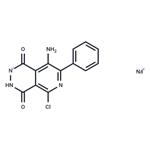L 012 Sodium Salt is a chemiluminescent dye used to detect superoxide in biological systems, specifically in whole blood, inflammatory cells, and vascular tissue.
L-012 is a luminol analog and a widely used reactive oxygen and nitrogen species (RONS; ROS & RNS) chemiluminescence (CL) probe both in cultures and in animals in vivo. L-012 displays significantly higher CL yield and sensitivity than luminol, lucigenin and MCLA. Instead of reacting with superoxide anion (O2-) directly, L-012 (LumH2) is converted via a one-electron oxidation (catalyzed by peroxidase in the presence of H2O2) to the LumH· radical form, which then reacts with oxygen (O2) to yield O2- and L-012 quinone (q-Lum). The O2- in turn reacts with the LumH· radical, leading eventually to an endoperoxide th at decomposes to emit luminescence. To a less extend, H2O2 can also react with q-Lum to yield luminescence. Although not specific to NADPH oxidase-derived RONS, L-012 is also commonly used for screening NADPH oxidase inhibitors.
![sodium 8-amino-5-chloro-1-oxo-7-phenyl-2H-pyrido[3,4-d]pyridazin-4-olate Structure](/CAS/20180529/GIF/143556-24-5.gif)
